Chinese Name: 天府广场 Pronunciation: Tiānfǔ Guǎngchǎng
Building Time: 1951
Recommended Time for Visit: Half a day
Occupied Area: About 88,000 square meters
Address: Renmin South Road, Jinjiang District, Chengdu, Sichuan Province, China
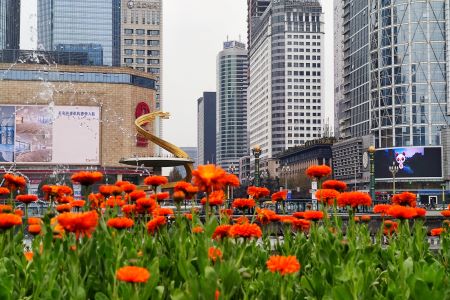
Tianfu Square, the political and cultural center and comprehensive transportation hub of Sichuan Province, is located at the Renmin South Road, Jinjiang District, Chengdu City, Sichuan Province.
Tianfu Square is at the center of Chengdu City and is the starting point of Renmin Middle Road, Renmin East Road, Renmin West Road and Renmin South Road. Its form and status are similar to Tian’anmen Square in Beijing.
As the economic, cultural, and commercial center of Chengdu, Tianfu Square is well connected by transportation lines and is a business card of Chengdu.
It is the subway transportation hub of Chengdu. Tianfu Square Subway Station is located directly under Tianfu Square. It is a Subway station managed and operated by Chengdu Rail Transit Group Co., Ltd. It is the transfer station of Chengdu Subway Line 1 and Line 2. From Tianfu Square Station, visitors can get to Sunken Square, Xiyu Street, Xiaohe Street, the ground square, Shudu Avenue, Jincheng Art Palace, Chengdu People’s Government, and Sichuan Science and Technology Museum.
Tianfu Square covers an area of about 88,000 square meters, with a rectangular shape. The ground is all paved with light-colored granite strips treated with special technology. The square has always been a symbol of Chengdu City and Sichuan Province.
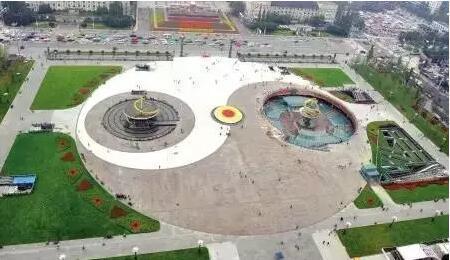
Daoism is the native religion of China, and the Taiji Diagram or Diagram of the Universe is the most representative of the religion. The square is composed of Daoism elements from different perspectives. As for the center part, the Bagua or Eight Diagrams (eight combinations of three lines to form 64 hexagrams used in divination) are particularly conspicuous and contain a wealth of traditional cultures. The design of the Taiji Diagram in the square contains rich cultural colors.
Besides, the statue of Mao Zedong, the founder of the People’s Republic of China is at the north of Tianfu Square. Its height reaches 30 meters. The great leader Chairman Mao stretches out his hand to say hello to the people of Chengdu.
Tianfu Square is not only a transportation hub but also a business card for Chengdu. All the attractions around it should not be missed. Around Tianfu Square, there are Sichuan Art Museum, Sichuan Provincial Library, Chengdu Museum, Sichuan Science and Technology Museum, and Sichuan Grand Theater.
The five public cultural venues have formed a huge “cultural chain” that makes Tianfu Square special and attractive. With the five buildings standing at the intersection of culture and history, the status of Tianfu Square is self-evident.
However, in addition to the eye-catching treasures such as museums, libraries, and galleries, there is also a food street hidden under Tianfu Square. A variety of delicious foods gather here, which is the paradise for visitors who love Chinese food such as Xishu cream puff(Xishu is the brand name), Soufflé, Agan Guokui(a kind of thin pancake made from flour, stuffed with preserved vegetables), Pan-Fried Bun Stuffed with Pork, and various noodles that are very attractive for foreigners.
In 347 BC of the Warring States Period, Kaiming King IX of the Shu moved his capital to Chengdu and established “Beishaocheng” City on Chengdu Plain. The capital was located in the Wudan Mountain area to the north of today’s Tianfu Square.
In 311 BC, after the Qin State destroyed the Shu State, Zhang Yi, a senior official from the Qin State, built “Dacheng” City and “Shaocheng” City, following the design of Xianyang City of the Qin in the south and west of the Imperial City of Shu. (Tianfu Square in 2018 was just to the west of the center of Dacheng at that time).
In 876 during the Tang Dynasty, Sichuan Governor Gao Pian took “Dacheng” as the center and expanded a new city called “Tang Luocheng”. The former inner-city “Dacheng” was transformed into “Zicheng” (Son City).
In 908, Wang Jian claimed himself to be the new emperor of Sichuan, and the state was called “Dashu” (or “Qianshu” in history). The next year, Wang Jian changed “Zicheng” into the imperial city and “Shuwangfu” (the Shu King’s Palace).
In 1371, Zhu Chun, the son of Zhu Yuanzhang, the first emperor of the Ming Dynasty, was granted the title of “King of Shu”, whose palace was rebuilt on the original site. The new “Shuwangfu” changed the layout of the main axis of Chengdu City in the past dynasties and established the North-South central axis for the first time.
Although it was a palace, it seemed to have the majestic style of the imperial palace, so people called it the “imperial city”. The archway, arch bridge and a large open space in front of it were called Imperial City Dam(Huangchengba in Chinese). The location of the “imperial city” and “imperial city dam” was in the north end of Tianfu Square in 2018.
In 1644 during the Taiping Revolution, Zhang Xianzhong conquered Chengdu City and used “Shuwangfu” as his palace. Two years later, when he left, he set fire to the city and then “Shuwangfu” was destroyed.
In 1655, the government of the Qing Dynasty changed the former site of “Shuwangfu” into “Gongyuan” (the examination center for the imperial examination), which became the place for candidates of the imperial civil examination in Sichuan Province.
After the 1950s, in the large-scale urban transformation, the “imperial city” and the “imperial city dam” suffered great damage and disappeared.
In 1951, the 70-meter wide Renmin South Road was built to the south of the gate of the “imperial city”.
In 1997, under the government’s executive order of expanding the central square, the houses on both sides of Tianfu Square were quickly demolished.
In 2007, the bidding for the international design of planned cultural facilities around Tianfu Square was organized by Chengdu Municipal Bureau of Culture.
In 2011, a large-scale renovation was carried out on Tianfu Square. The original oval Taiji pattern was transformed into a circle one with a diameter of 150 meters. The green area was adjusted and the air vent was set in the southeast corner. The whole construction took about two months.
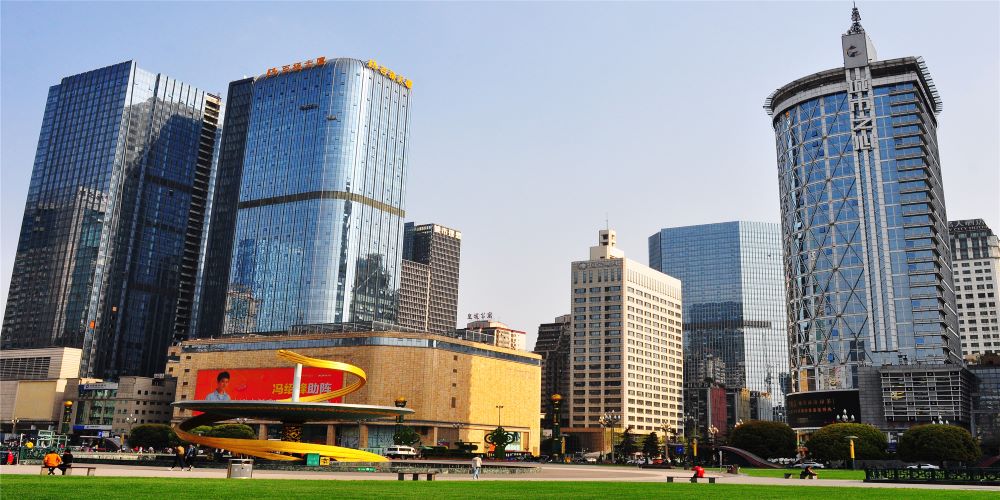
Before the construction of the new square, the government proposed three plans, namely, Water Township Square, Taiji Square, and Shu-Character Square, for the public to vote. The design of Taiji Square gained more popular votes than the other two. Hence Tianfu Square follows the pattern of Taiji Diagram.
The design is dominated by “water”. The central curve of a Taiji cloud diagram (Bagua Diagram) naturally divides the square into two parts, and the east square is a sunken square, the west square is a fountain landscape, and the middle is the pattern of sunbird.
Both the east and west squares have Taiji fish-eye sculptures as the core. In the waterscape of the west square, the Taiji fish-eye assumes the function of a fountain. As you can see, in the center of the rippling pool and the fish-eye is divided into three layers, and white-water columns are sprayed out layer by layer.
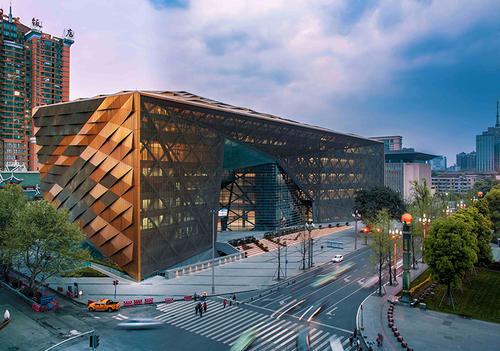
Chengdu Museum is the largest comprehensive museum in Chengdu, with a history of more than 50 years. The museum is located on the west side of Tianfu Square, adjacent to Sichuan Provincial Library, Sichuan Art Museum, and Sichuan Science and Technology Museum. The museum mainly disseminates Chengdu’s history and culture to the public through the collection, protection, research and display of cultural relics, and strives to provide the city with diversified public cultural services.
It covers an area of about 11,333 square meters and has a total construction area of 65,000 square meters with a total exhibition area of nearly 20,000 square meters. The internal space is divided into Public Activity Area, Exhibition Area, Cultural Relic Storage Area, Office Area, etc.
The main building of the museum is divided into the south building and the north building. The south building is mainly the administrative area and the academic lecture hall (multifunctional hall). The north building is mainly the exhibition area. The total collection of Chengdu Museum is nearly 200,000 pieces, forming a relatively complete sequence of collections from the Neolithic period down to the Republican period, covering bronze, gold and silver, portrait bricks, stone carvings, ceramics, calligraphy and painting, furniture, shadow puppets, masks, wood carvings, etc.
Sichuan Provincial Library is located to the northeast of Tianfu Square. It is one of the earliest public libraries in China, and a first-level library in Sichuan Province.
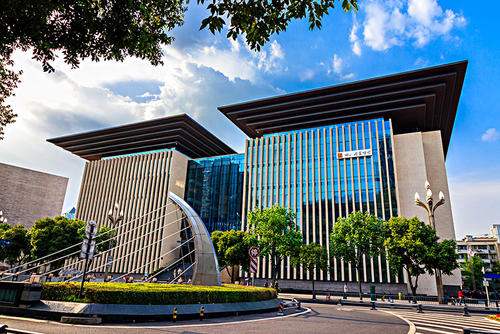
The Sichuan Provincial Library was originally established in 1912, and in 1927 it was renamed Chengdu Library. It was renamed Sichuan West People’s Library in 1942 and Sichuan Provincial Library in 1952. It opened to the public in December 2015.
As of December 2017, Sichuan Provincial Library has more than 5 million books, including 650,000 ancient books and 220,000 documents from the period of the Republic of China, with a digital resource of 150TB. The library has a building area of 52,000 square meters.
As of the end of 2016, Sichuan Provincial Library had introduced services including a “one-card” service, “Sichuan Library” WeChat public account, mobile library, 24-hour self-service library, RFID self-service loan, and return system, self-service card for loan service, mobile APP, etc.
After development for more than 100 years, Sichuan Provincial Library has made positive contributions to promoting the inheritance of excellent Chinese culture, and meeting the needs of readers for a better life.
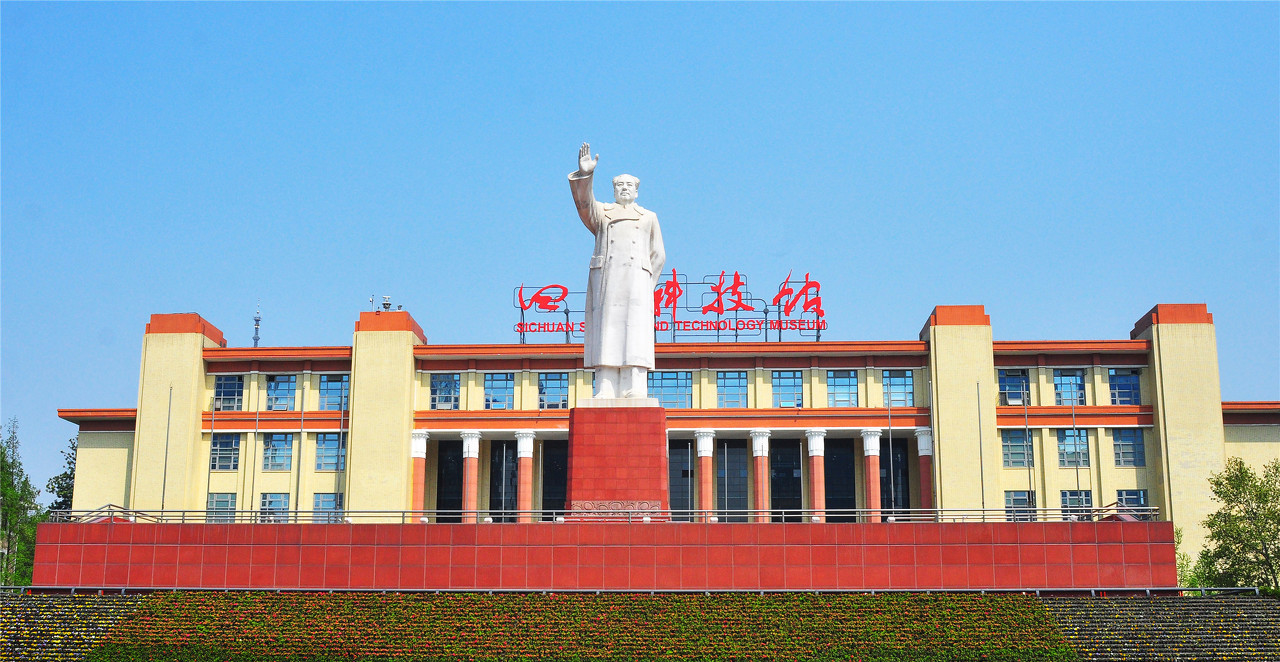
Sichuan Science and Technology Museum is one of “the Ten Landmark Projects” for cultural facilities construction during the “Tenth Five-Year Plan” period determined by Sichuan Province. The museum is located on the north side of Tianfu Square in the center of Chengdu, a landmark of the cultural expo area in the central business district of Chengdu. In December 2020, the museum was appraised as “National Advanced Collective for Science Popularization”.
The museum was officially opened on November 2, 2006, with a total area of 41,800 square meters, including more than 20 permanent exhibition halls (Aerospace Exhibition Area, Machinery Exhibition Area, Virtual World Exhibition Area, Robot Exhibition Area, and Information Technology Exhibition Area, Life Science Exhibition Area, Ecology and Environment Exhibition Area, etc.) and three theme exhibitions.
The museum covers an area of 60,000 square meters and a building area of 41,800 square meters. The permanent exhibition area in the hall is 25,000 square meters. The 20 exhibition areas on the first to fourth floors include 4D cinema, Dujiangyan, Jiuzhai and Huanglong, aerospace, robotics, virtual world, information society, mathematics, youth science and technology park, crazy science show, robot studio, etc.
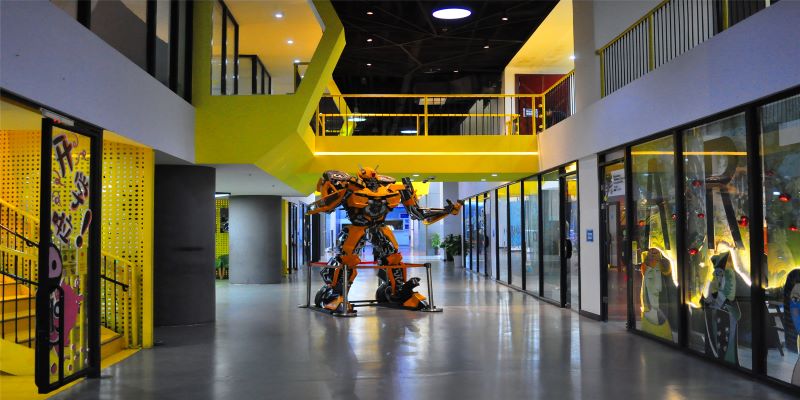
The exhibitions integrate science, knowledge, interest, activity and artistry, and use modern display methods such as sound, light and electricity to vividly popularize scientific and technological knowledge to the public.
Sichuan Science and Technology Museum is built with nearly 3,000 square meters of indoor temporary exhibition halls, nearly 5,000 square meters of outdoor activity space, 220-seat academic lecture halls and multifunctional academician halls. It provides the public with a variety of popular science exhibitions and activities to publicize and promote popular science knowledge to young people.
Sichuan Science and Technology Museum is free of charge, but visitors need to make an online appointment, and each visitor is limited to one ticket on that day. The opening hours are 9:00 to 17:00, and visitors are not allowed to check in after 16:30.
Sichuan Art Museum, at the northwest side of Tianfu Square, is located at the intersection of Dongchenggen Street and Renmin West Road, Qingyang District, Chengdu.
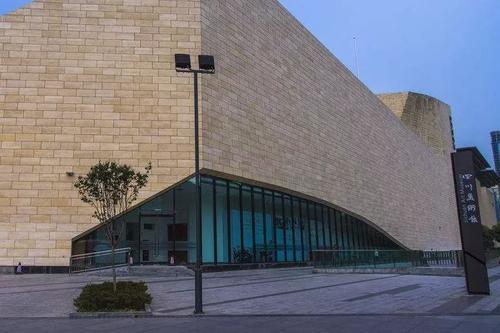
It is an avant-garde building with a height of 38 meters and covers an area of about 7,333 square meters and has a total construction area of 19,000 square meters.
It is composed of a polygonal main building and a rectangular auxiliary building. The auxiliary building adopts a sloped roof. Seeing from the front entrance, the wall is like a opened curtain, which is very beautiful and modern.
Since its opening in 1992, Sichuan Art Museum has held about 50 exhibitions each year, and carried out various academic exchange activities for five to six times a year. It receives 100,000 visitors per year, including several batches of foreign guests.
In recent years, Sichuan Art Museum has held several provincial art exhibitions each year, as well as several famous painting exhibitions, such as Xu Beihong’s Painting Exhibition, Pan Tianshou’s Painting Exhibition, National Printmaking Exhibition, National Landscape Exhibition, and Chinese Painting Exhibition of Western China. In particular, some have a high reputation and influence at home and abroad, like South Korea, Denmark, France, and other countries.
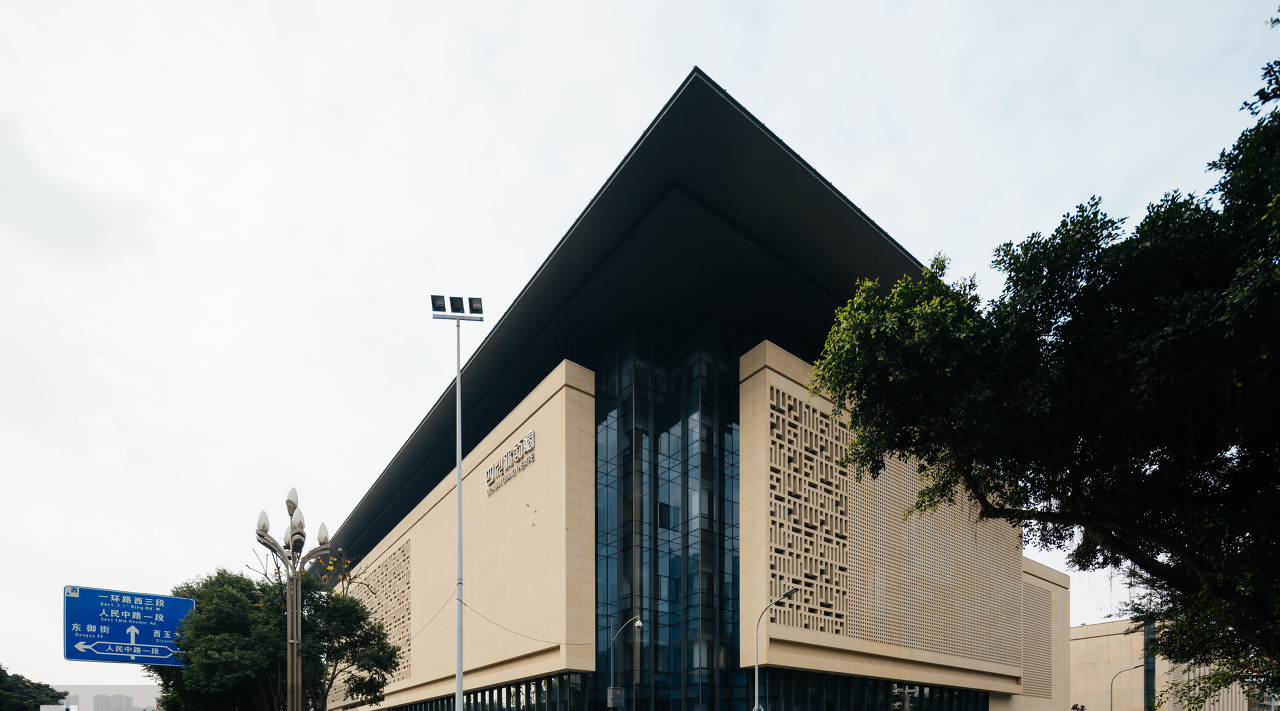
Sichuan Grand Theater is located at No. 1, Renmin Middle Road, Chengdu (the site of the original Telecom Bell Tower), and was formerly the Sichuan Jincheng Art Palace, built in 1987.
The appearance of the new Sichuan Grand Theater adopts the three-stage composition of the ancient official architecture, and it is square and atmospheric. The glass slope roof is lively and transparent.
It forms a harmonious whole with the nearby Sichuan Provincial Library and Sichuan Science and Technology Museum, and even its height is as same as 38 meters with the two.
Inside the theater, a 1601-seat theater can cater for large-scale performances, and a 450-seat small theater can stage various performances that do not require a gorgeous scene.
Sichuan Grand Theatre has the ability and condition to host world-class performances, including large-scale opera, dance, ballet, symphony performances and comprehensive cultural performances, as well as small and medium-sized performances.
Sichuan Grand Theatre is the most influential comprehensive cultural and artistic facility in the southwest of China, providing high-end cultural and artistic works for art lovers in the society. It delivers the most unique and loudest Sichuan voice to whole China and even the whole world with its distinct Sichuan style.
Chengdu is a famous cultural city with a long history. It has a history of more than two thousand years from the time it was accurately recorded, but do not think that Chengdu’s current prosperity has continued since more than 2,000 years ago.

Older generations of Chengdu people know that the now majestic Tianfu Square was called Imperial City Dam(Huangchengba in Chinese) a hundred years ago, and it was a place where the Hui people lived and sold popular local snacks.
The site behind the statue of Chairman Mao is that of the “imperial city” of the kings of Shu State in history. After the Revolution of 1911, the imperial city began to be used as one office of the military government, which had been robbed to death by warlords.
Near the imperial city, the houses were completely destroyed, and the imperial city itself was once ruined, and there were ruined walls everywhere. Later, the Sichuan government set some schools in this place one after another and built houses here.
Later, National Chengdu Normal University, National Chengdu University, and Public Sichuan University merged into National Sichuan University.
Tianfu Square itself does not take much time to visit at daytime. Its night view is gorgeous.
But do remember to enjoy history at Chengdu Museum, appreciate art works at Sichuan Art Museum, spend one afternoon reading books and magazines at Sichuan Provincial Library, arouse Children’s curiosity at Sichuan Science and Technology Museum, and watch a performance at Sichuan Grand Theater. These attractions are all around Tianfu Square.
Take bus 16, 53, 45, 61, 64, night 12, night 5 or night 8 and get off at the Station of Tianfu Square East. And then you need a 8-minute walking to the destination(in the west).
Take bus 16, 26, 61, 78, G67 or G97 and get off at the Station of Tianfu Square South. And then you need a 6-minute walking to the destination(in the northwest).
Take Subway Line 1 or 2 and get off at Tianfu Square Station.
Chinese: 请带我去天府广场。English: Please take me to Tianfu Square.
If you go to Tianfu Square from Sheraton Chengdu, it takes about 10 minutes (about 10 yuan).
If you go to Tianfu Square from Chengdu East Railway Station, it takes about 35 minutes (about 25 yuan).
If you go to Tianfu Square from Chengdu Shuangliu International Airport, it takes about 50 minutes (about 50 yuan).
